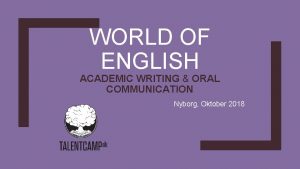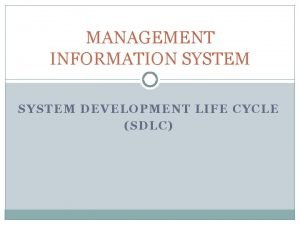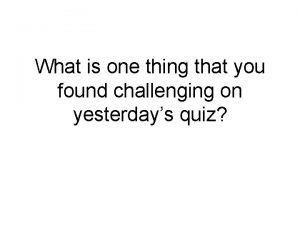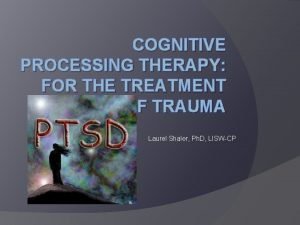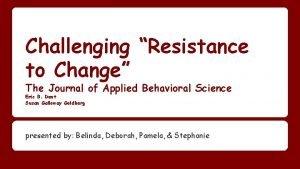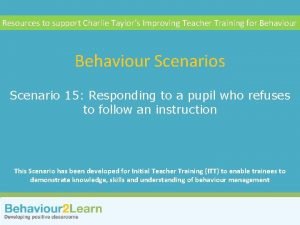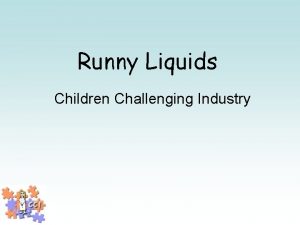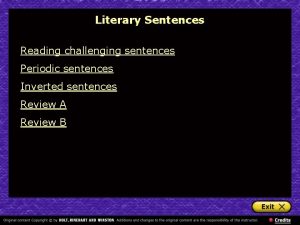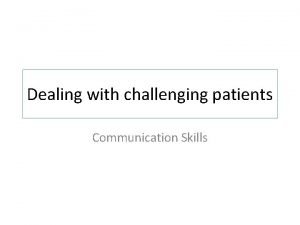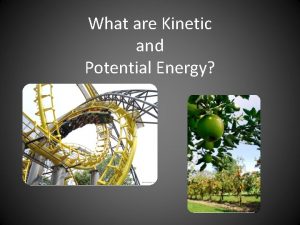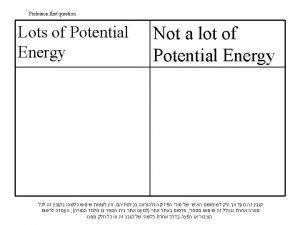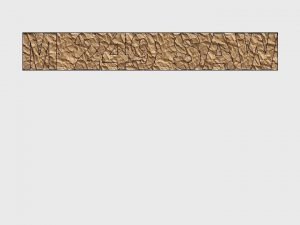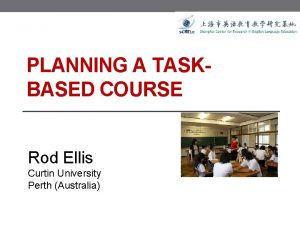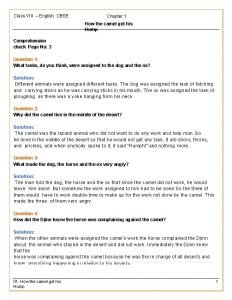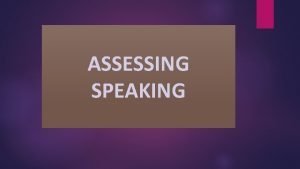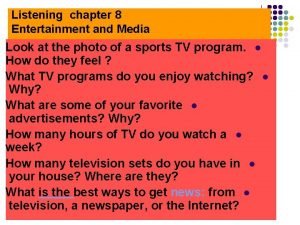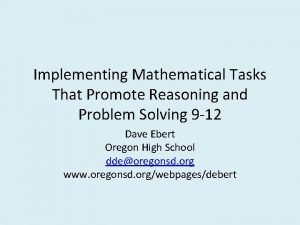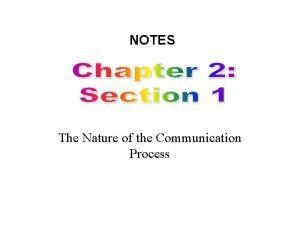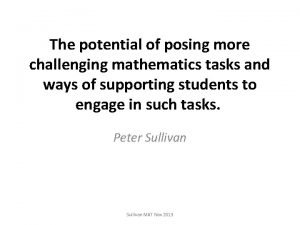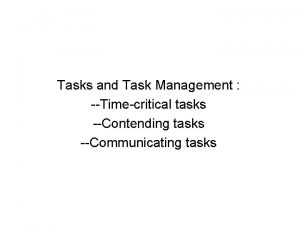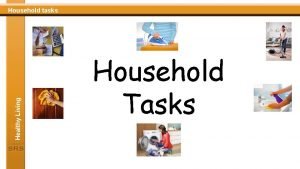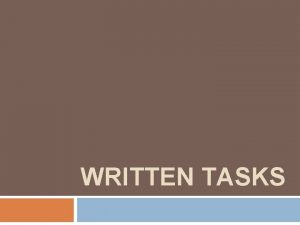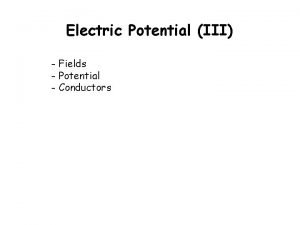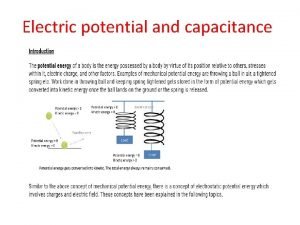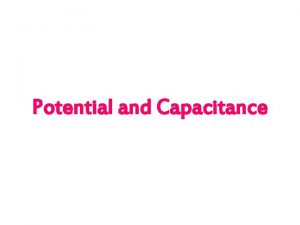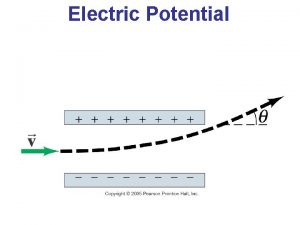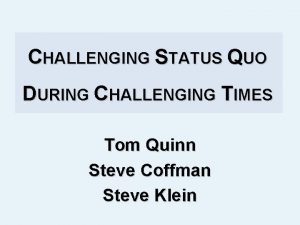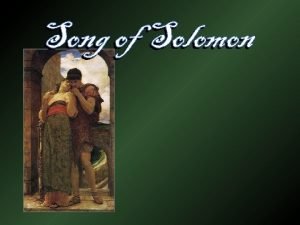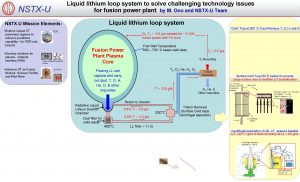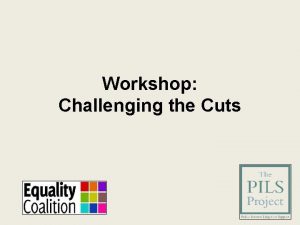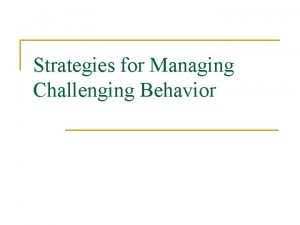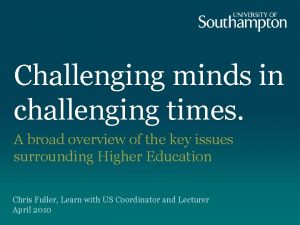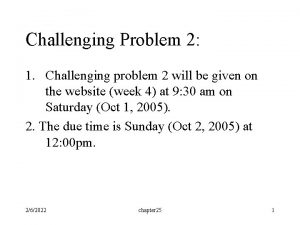The potential of posing more challenging tasks and


































































































- Slides: 98

The potential of posing more challenging tasks and ways of supporting students to engage in such tasks (Years K-10) Peter Sullivan MAT june 2013

Abstract While most students want to work on more challenging mathematics, there are still some who require substantial support. The workshop will explore examples of tasks with low "floors" but high "ceilings" that allow all students to engage with the tasks at some level, but which can be extended productively for those who are ready. A particular lesson structure that supports the work of all students on such tasks will be presented and discussed. MAT june 2013

Overview • A rationale for the proposition • Some suggestions of (a few) lessons • Creating your own MAT june 2013

Which of these are your top two priorities, that students … Enjoy the mathematics they are learning See the usefulness the mathematics to them Be able to interpret the world mathematically See the connection between mathematics learning and their future study and career options • Know that they can learn mathematics • Know that they can get smarter by trying hard • • MAT june 2013

For students to learn, two sets of factors must align • The first set of factors include that the: –students have the requisite prior knowledge; –curriculum is relevant to them; –classroom tasks match their expectations; –classroom tasks help them make connections –pedagogies use their knowledge and experience; –assessment regimes measure their learning. MAT june 2013

The second set of factors relates to • whether the students – are motivated to learn – see participation in schooling as creating opportunities – are willing to persist – connect effort and success MAT june 2013

Where does the idea of “challenge” come from? • Guidelines for school and system improvement (see, e. g. , City, Elmore, Fiarman, & Teitel, 2009) • The motivation literature (Middleton, 1995; 1999). • Sets of teaching principles – Principles of Learning and Teaching, 2009 – Productive Pedagogies, 2009 MAT june 2013

Why challenge? • Learning will be more robust if students connect ideas together for themselves, and determine their own strategies for solving problems, rather than following instructions they have been given. • Both connecting ideas together and formulating their own strategies is more complex than other approaches and is therefore more challenging. • It is potentially productive if students are willing to take up such challenges. MAT june 2013

This connects to “mindsets” • Dweck (2000) categorized students’ approaches in terms of whether they hold either growth mindset or fixed mindset MAT june 2013

Students with growth mindset: • Believe they can get smarter by trying hard • Such students – tend to have a resilient response to failure; – remain focused on mastering skills and knowledge even when challenged; – do not see failure as an indictment on themselves; and – believe that effort leads to success. MAT june 2013

Students with fixed mindset: • Believe they are as smart as they will even get • Such students – seek success but mainly on tasks with which they are familiar; – avoid or give up quickly on challenging tasks; – derive their perception of ability from their capacity to attract recognition. MAT june 2013

Teachers can change mindsets • This connects to – the things we affirm (effort, persistence, cooperation, learning from others, flexible thinking) – the way we affirm • You did not give up even though you were stuck • You tried something different • You tried to find more than one answer – the types of tasks we pose MAT june 2013

Challenging tasks require students to • plan their approach, especially sequencing more than one step; • process multiple pieces of information, with an expectation that they make connections between those pieces, and see concepts in new ways; • choose their own strategies, goals, and level of accessing the task; • spend time on the task and record their thinking; • explain their strategies and justify their thinking to the teacher and other students. MAT june 2013

Getting started “zone of confusion” “four before me” • representing what the task is asking in a different way such as drawing a cartoon or a diagram, rewriting the question … • choosing a different approach to the task, which includes rereading the question, making a guess at the answer, working backwards … • asking a peer for a hint on how to get started • looking at the recent pages in the workbook or textbook for examples. MAT june 2013

From some current research MAT june 2013

17. I know I have between 15 and 25 apples. When they are put into groups of 6 there are 2 apples left over. How many apples do I have? ANSWER PRE -TEST POST- TEST It is not possible to tell 18 20 22 Total MAT june 2013

17. I know I have between 15 and 25 apples. When they are put into groups of 6 there are 2 apples left over. How many apples do I have? ANSWER PRE -TEST POST- TEST ✘ It is not possible to tell 20% 14% ✘ 18 25% 22% ✔ 20 40% 48% ✘ 22 15% 16% Total 100% MAT june 2013

PRE- TEST POST- TEST I am very confident that I answered the apples question correctly 26% 34% 53% 52% 21% 14% 100% I am quite confident that I answered the apples question correctly I am not confident that I answered the apples question correctly TOTAL MAT june 2013

PRE- TEST POST -TEST 29% 34% I prefer tasks I work on in class to be about as hard as the apples question 56% 55% I prefer tasks I work on in class to be much easier than the apples question 15% 12% 100% I prefer tasks I work on in class to be much harder than the apples question TOTAL MAT june 2013

PRE TEST POST TEST 39% 41% I prefer to work on tasks like the apples question with other students 44% 47% I prefer to be told what to do by the teacher 17% 12% 100% I prefer to work out tasks like the apples question for myself TOTAL MAT june 2013

This is a paddock in the shape of an L. The area is 1 hectare. How many metres wide is the top part of the L? (A square 100 m x 100 m has an area of 1 hectare) (Diagram not drawn to scale) MAT june 2013

16. This is a paddock in the shape of an L. The area is 1 hectare. How many metres wide is the top part of the L? (A square 100 m x 100 m has an area of 1 hectare) (Diagram not drawn to scale) Pre -Test 4 % correct Post-Test 21 % correct MAT june 2013

Answer Pre-Test Post-Test I am very confident that I answered the paddock question correctly 14% 15% I am quite confident that I answered the paddock question correctly 51% 53% I am not confident that I answered the paddock question correctly 34% 32% 100% MAT june 2013

Answer Pre-Test Post-Test 16% I prefer tasks I work on in class to be about as hard as the paddock question 62% 61% I prefer tasks I work on in class to be much easier than the paddock question 22% 23% 100% I prefer tasks I work on in class to be much harder than the paddock question MAT june 2013

Answer Pre-Test Post-Test I prefer to work out tasks like the paddock question for myself 31% 32% I prefer to work on tasks like the paddock question with other students 54% 58% I prefer to be told what to do by the teacher 15% 11% 100% MAT june 2013

An illustrative lesson MAT june 2013

MAT june 2013

Year 5 Money and financial mathematics Create simple financial plans (ACMNA 106) Number and place value Use estimation and rounding to check the reasonableness of answers to calculations (ACMNA 099) • Use efficient mental and written strategies and apply appropriate digital technologies to solve problems (ACMNA 291) • • MAT june 2013

Year 6 • Money and financial mathematics • Investigate and calculate percentage discounts of 10%, 25% and 50% on sale items, with and without digital technologies (ACMNA 132) • Number and place value • Select and apply efficient mental and written strategies and appropriate digital technologies to solve problems involving all four operations with whole numbers (ACMNA 123) MAT june 2013

How is this represented in the AC? MAT june 2013

At year 5: • Understanding includes making connections between representations … • Fluency includes … using estimation to check the reasonableness of answers to calculations • Problem Solving includes formulating and solving authentic problems using whole numbers and creating financial plans • Reasoning includes investigating strategies to perform calculations … MAT june 2013

At year 6: • Understanding includes … making reasonable estimations • Fluency includes … calculating simple percentages • Problem Solving includes formulating and solving authentic problems • Reasoning includes explaining mental strategies for performing calculations, MAT june 2013

In preparation for the lesson, please read the rubric • I will ask you to self assess • Hint: Write neatly MAT june 2013

Jenny and Carly go shopping for shoes. Jenny chooses one pair for $110 and another for $100. Carly chooses a pair that cost $160. al offer ofpfeerci Special S pay, the assistant ICES FOR THE PARIR E H T R P O E F E S R IR A H T THREE P TWO F O a sale on, and they PRICE OF TWO When they go to says that there is get 3 pairs of shoes for the price of 2 pairs. Give two options for how much Jenny and Carly should each pay? Explain which option is fairer. MAT june 2013 e st one the cheapest on The free pair is the cheape

Representing the situation MAT june 2013

$160 $100 Carly $110 Jenny MAT june 2013

$160 $100 This pair is free $110 Carly Jenny MAT june 2013

The sharing option They have to pay $270 • So Jenny pays $180 and Carly pays $90 MAT june 2013

The Saving Option They save $100 • If they share the saving equally, – Then Jenny pays $210 - $50 = $160 – Carly pays $160 - $50 = $110 MAT june 2013

A Consolidating Task • Jenny and Carly go shopping for shoes. Jenny chooses one pair for $110 and another for $100. Carly chooses a pair that cost $60. When they go to pay, the assistant says that there is a sale on, and they get 3 pairs of shoes for the price of 2 pairs (the cheapest pair becomes free). Give two options for how much Jenny and Carly should each pay? Explain which is the fairer. • Explain in what ways the fairer solution depends on the cost of Carly’s shoes. MAT june 2013

Enabling Prompt: Kerry and Kathy are twins and can share shoes. Kerry chooses one pair for $20. Kathy chooses a pair that costs $40. How much should they each pay? MAT june 2013

An extending task Bert, Bob and Bill are shopping for shirts. Today o nly FIVE SHI RTS FOR THE PRI CE OF THREE The free ties are the chea per one s Bill chooses a shirt costing $30 and another for $50. Bob chooses one shirt for $60. Bert chooses one shirt for $30 and another for $40. When they go to pay, the assistant says that there is a sale on, and they get 5 shirts for the price of 3. Give two options for how much Bill and Bert and Bob should each pay? Explain which is the fairest. MAT june 2013

What would be the point of asking a question like that? What might make it difficult? MAT june 2013

Using the Rubric • Assess yourself on your answer(s) to the shoes question MAT june 2013

How might you adapt the shoes task if you are teaching grade 2? MAT june 2013

97 + 92 + 3 3 + 3 + 17 3+4+6+7 1 + 2 + 3 + 19 + 18 + 17 998 + 157 + 2 11 + 12 + 19 What advice would you give to someone about working out answers like these in your head? MAT june 2013

For the students: • If you are given the surface area of a rectangular prism, you are able to work out what the prism might look like. MAT june 2013

Surface area = 22 • A rectangular prism is made from cubes. • It has a surface area of 22 square units. • Draw what the rectangular prism might look like? MAT june 2013

Consolidating • The surface area of a closed rectangular prism is 46 cm 2. • What might be the dimensions of the prism? MAT june 2013

Introductory task: • What is the surface area and volume of a cube that is 2 cm × 2 cm? MAT june 2013

Enabling prompt: • Arrange a small number of cubes into a rectangular prism, then calculate the volume and surface area. MAT june 2013

Extending prompt: • The surface area of a closed rectangular prism is 94 cm 2. • What might be the dimensions of the prism? MAT june 2013

A probability task MAT june 2013

First do this task • On a train, the probability that a passenger has a backpack is 0. 6, and the probability that a passenger as an MP 3 player is 0. 7. • How many passengers might be on the train? • How many passengers might have both a backpack and an MP 3 player? • What is the range of possible answers for this? • Represent each of your solutions in two different ways. MAT june 2013

Starting from the content descriptions MAT june 2013

Reading the content description(s) to identify the key ideas • Represent events in two-way tables and Venn diagrams and solve related problems (ACMSP 292) MAT june 2013

Reading the content description(s) to identify the key ideas • Represent events in two-way tables and Venn diagrams and solve related problems (ACMSP 292) MAT june 2013

Reading the content description(s) to identify the key ideas • Represent events in two-way tables and Venn diagrams and solve related problems (ACMSP 292) MAT june 2013

Reading the content description(s) to identify the key ideas • Represent events in two-way tables and Venn diagrams and solve related problems (ACMSP 292) MAT june 2013

Reading the content description(s) to identify the key ideas • Represent events in two-way tables and Venn diagrams and solve related problems (ACMSP 292) MAT june 2013

What would we say to the students are the learning goals/intentions? • Devising for ourselves different ways of representing categorical data MAT june 2013

Assume we have 10 people 1 2 3 4 5 6 BP BP BP MP 3 MP 3 MAT june 2013 7 MP 3 8 9 10

Assume we have 10 people 1 2 3 4 5 6 BP BP BP MP 3 MP 3 MAT june 2013 7 8 MP 3 9 10

Assume we have 10 people 1 2 3 4 5 6 BP BP BP MP 3 MAT june 2013 7 8 9 MP 3 10

Assume we have 10 people 1 2 3 4 5 6 BP BP BP MP 3 MAT june 2013 7 8 9 10 MP 3

MAT june 2013

Two way tables back pack No back pack MP 3 player No MP 3 player 3 4 3 0 MAT june 2013

Venn diagrams Back pack MP 3 player 3 3 4 0 MAT june 2013

What about the students who cannot get started? An enabling prompt • On a train, there are 10 people. • Six of the people have a backpack, and 7 of the people have an MP 3 player. • How many people might have both a backpack and an MP 3 player? • What is the smallest possible answer for this? • What is the largest possible answer? MAT june 2013

What are enabling prompts? • Enabling prompts can involve slightly varying an aspect of the task demand, such as – the form of representation, – the size of the numbers, or – the number of steps, so that a student experiencing difficulty, if successful, can proceed with the original task. • This approach can be contrasted with the more common requirement that such students – listen to additional explanations; or – pursue goals substantially different from the rest of the class. MAT june 2013

An extending prompt • On a train, the probability that a passenger has a backpack is 2/3, and the probability that a passenger has an MP 3 player is 2/7. How many passengers might be on the train? How many passengers might have both a backpack and an MP 3 player? What is the range of possible answers for this? • Represent each of your solutions in two different ways. MAT june 2013

Thinking about what comes next MAT june 2013

A consolidating task • On a train, the probability that a passenger has a backpack is 0. 65, and the probability that a passenger as an MP 3 player is 0. 57. • How many passengers might be on the train? • What is the maximum and minimum number of possibilities for people who have both a backpack and an MP 3 player? • Represent each of your solutions in two different ways. MAT june 2013

Missing number multiplication MAT june 2013

Our goal • Sometimes solving multiplication and division problems is about finding patterns. • In this case look for numbers that when multiplied have an answer that ends in 0. MAT june 2013

Missing digit This number has a digit missing __ 4 What might be the number? MAT june 2013

The question • I did a multiplication question correctly for homework, but my printer ran out of ink. I remember it looked like 2_x 3_=__0 • What might be the digits that did not print? (Give as many answers as you can) MAT june 2013

If you are stuck • What might be the missing digits __ × __ = __ 0 MAT june 2013

If you are finished • What might be the missing digits? _ x _ 0 x 3 _ = _ _ 0 MAT june 2013

Now do this • I did a multiplication question correctly for homework, but my printer ran out of ink. I remember it looked like 1 __ × 4 __ = __ __ 2 • What might be the digits that did not print? • (give as many answers as you can) MAT june 2013

We said our goal was … • Sometimes solving multiplication and division problems is about finding patterns. • In this case look for numbers that when multiplied have an answer that ends in 0. MAT june 2013

MAT june 2013

Surface area = 22 • A rectangular prism is made from cubes. • It has a surface area of 22 square units. • Draw what the rectangular prism might look like? MAT june 2013

For the students: • If you are given the surface area of a rectangular prism, you are able to work out what the prism might look like. MAT june 2013

Introductory task: • What is the surface area and volume of a cube that is 2 cm × 2 cm? MAT june 2013

Enabling prompt: • Arrange a small number of cubes into a rectangular prism, then calculate the volume and surface area. MAT june 2013

Extending prompt: • The surface area of a closed rectangular prism is 94 cm 2. • What might be the dimensions of the prism? MAT june 2013

• The surface area of a closed rectangular prism is 46 cm 2. • What might be the dimensions of the prism? MAT june 2013

The notion of classroom culture • Rollard (2012) concluded from the meta analysis that classrooms in which teachers actively support the learning of the students promote high achievement and effort. We interpret this to refer to ways that teachers can support students in engaging with the challenge of the task, and in maintaining this challenge as distinct from minimising it. MAT june 2013

Some elements of this active support : • the identification of tasks that are appropriately challenging for most students; • the provision of preliminary experiences that are pre-requisite for students to engage with the tasks but which do not detract from the challenge of the task; • the structuring of lessons including differentiating the experience through the use of enabling and extending prompts for those students who cannot proceed with the task or those who complete the task quickly; MAT june 2013

• the potential of consolidating tasks, which are similar in structure and complexity to the original task, with which all students can engage even if they have not been successful on the original task; • the effective conduct of class reviews which draw on students’ solutions to promote discussions of similarities and differences; • holistic and descriptive forms of assessment that are to some extent self referential for the student and which minimise the competitive aspects; and • finding a balance between individual thinking time and collaborative group work on tasks. MAT june 2013

Task: Representing probability in different ways MAT june 2013

First • • • A T A’ A A T T MAT june 2013

Thinking about the lesson structure • In this view, the sequence – Launch (without telling) – Explore (for themselves) – Summarise (drawing on the learning of the students) Launch Summarise Explore • … is cyclical and might happen more than once in a lesson (or learning sequence) MAT june 2013

Choose one of the following tasks • Work through it • Write – Goal/learning intention – Introduction (if needed) – Enabling prompt – Extending prompt – Consolidating task MAT june 2013

The tasks • I am thinking of a number. There is a 7 in the tens place. The hundreds place is more than the units place. What might be the number? • If Jim can paint his house in 4 days, and Sally (his wife) can paint the house in 5 days, how long will it take if the both paint together? • A number when rounded is 5. 8. What might be the number? MAT june 2013

• This is a design of paths in a rectangular garden. I know that one of the straight lines is 10 m long (but I forget which one). I know that at least one of the angles is 300. What might be the perimeter of the garden? (there is more than 1 answer) MAT june 2013

• Draw a quadrilateral that has one reflex angle, one obtuse angle and two acute angles. • Write your name using a single line that is 1 m long. MAT june 2013
 More more more i want more more more more we praise you
More more more i want more more more more we praise you More more more i want more more more more we praise you
More more more i want more more more more we praise you Posing board
Posing board Power pose
Power pose Phase of system development life cycle
Phase of system development life cycle Introduction to sdlc
Introduction to sdlc Ecwms
Ecwms Nerve action potential
Nerve action potential Equipotential lines
Equipotential lines Electric potential and potential energy
Electric potential and potential energy Flaccid turgid and plasmolysis
Flaccid turgid and plasmolysis Market potential and forecasting
Market potential and forecasting Electric potential
Electric potential Joules per coulomb
Joules per coulomb V = pe/q
V = pe/q Electric potential
Electric potential What i found challenging
What i found challenging Cognitive processing therapy worksheets
Cognitive processing therapy worksheets Challenging resistance to change
Challenging resistance to change Challenging behaviour scenarios
Challenging behaviour scenarios Challenging text examples
Challenging text examples Exciting, boring, dangerous, safe, interesting, challenging
Exciting, boring, dangerous, safe, interesting, challenging Time intensity model challenging behaviour
Time intensity model challenging behaviour Children challenging industry
Children challenging industry Periodic sentence example
Periodic sentence example Dealing with challenging patients
Dealing with challenging patients Why is water potential measured in pascals
Why is water potential measured in pascals How to calculate solute potential
How to calculate solute potential Graded potential vs action potential
Graded potential vs action potential Definition of graded potential
Definition of graded potential Action potential definition
Action potential definition Graded potential vs action potential
Graded potential vs action potential How to find pressure potential
How to find pressure potential Source of bioelectric potential
Source of bioelectric potential Hypopolarization
Hypopolarization Intubating dose succinylcholine
Intubating dose succinylcholine Axon hillock
Axon hillock Action potential resting potential
Action potential resting potential Electric potential energy
Electric potential energy Human history becomes more and more a race
Human history becomes more and more a race 5 examples of potential energy
5 examples of potential energy You have more potential than you think
You have more potential than you think 5 apples in a basket riddle
5 apples in a basket riddle The more you study the more you learn
The more you study the more you learn Aspire not to
Aspire not to Example of first law of motion
Example of first law of motion Knowing more remembering more
Knowing more remembering more More love to thee o lord
More love to thee o lord More choices more chances
More choices more chances Hát kết hợp bộ gõ cơ thể
Hát kết hợp bộ gõ cơ thể Slidetodoc
Slidetodoc Bổ thể
Bổ thể Tỉ lệ cơ thể trẻ em
Tỉ lệ cơ thể trẻ em Voi kéo gỗ như thế nào
Voi kéo gỗ như thế nào Tư thế worms-breton
Tư thế worms-breton Chúa sống lại
Chúa sống lại Môn thể thao bắt đầu bằng chữ f
Môn thể thao bắt đầu bằng chữ f Thế nào là hệ số cao nhất
Thế nào là hệ số cao nhất Các châu lục và đại dương trên thế giới
Các châu lục và đại dương trên thế giới Công của trọng lực
Công của trọng lực Trời xanh đây là của chúng ta thể thơ
Trời xanh đây là của chúng ta thể thơ Cách giải mật thư tọa độ
Cách giải mật thư tọa độ 101012 bằng
101012 bằng Phản ứng thế ankan
Phản ứng thế ankan Các châu lục và đại dương trên thế giới
Các châu lục và đại dương trên thế giới Thơ thất ngôn tứ tuyệt đường luật
Thơ thất ngôn tứ tuyệt đường luật Quá trình desamine hóa có thể tạo ra
Quá trình desamine hóa có thể tạo ra Một số thể thơ truyền thống
Một số thể thơ truyền thống Cái miệng bé xinh thế chỉ nói điều hay thôi
Cái miệng bé xinh thế chỉ nói điều hay thôi Vẽ hình chiếu vuông góc của vật thể sau
Vẽ hình chiếu vuông góc của vật thể sau Biện pháp chống mỏi cơ
Biện pháp chống mỏi cơ đặc điểm cơ thể của người tối cổ
đặc điểm cơ thể của người tối cổ Ví dụ giọng cùng tên
Ví dụ giọng cùng tên Vẽ hình chiếu đứng bằng cạnh của vật thể
Vẽ hình chiếu đứng bằng cạnh của vật thể Phối cảnh
Phối cảnh Thẻ vin
Thẻ vin đại từ thay thế
đại từ thay thế điện thế nghỉ
điện thế nghỉ Tư thế ngồi viết
Tư thế ngồi viết Diễn thế sinh thái là
Diễn thế sinh thái là Dot
Dot Bảng số nguyên tố lớn hơn 1000
Bảng số nguyên tố lớn hơn 1000 Tư thế ngồi viết
Tư thế ngồi viết Lời thề hippocrates
Lời thề hippocrates Thiếu nhi thế giới liên hoan
Thiếu nhi thế giới liên hoan ưu thế lai là gì
ưu thế lai là gì Hổ sinh sản vào mùa nào
Hổ sinh sản vào mùa nào Sự nuôi và dạy con của hươu
Sự nuôi và dạy con của hươu Sơ đồ cơ thể người
Sơ đồ cơ thể người Từ ngữ thể hiện lòng nhân hậu
Từ ngữ thể hiện lòng nhân hậu Thế nào là mạng điện lắp đặt kiểu nổi
Thế nào là mạng điện lắp đặt kiểu nổi Task conditions and standards example
Task conditions and standards example Focused and unfocused tasks examples
Focused and unfocused tasks examples Natural science and technology grade 4 term 3
Natural science and technology grade 4 term 3 Describe how dog horse and ox turned against the man
Describe how dog horse and ox turned against the man Example of intensive speaking
Example of intensive speaking Listening about entertainment
Listening about entertainment Implement tasks that promote reasoning and problem solving
Implement tasks that promote reasoning and problem solving 5 principles of effective oral communication
5 principles of effective oral communication



